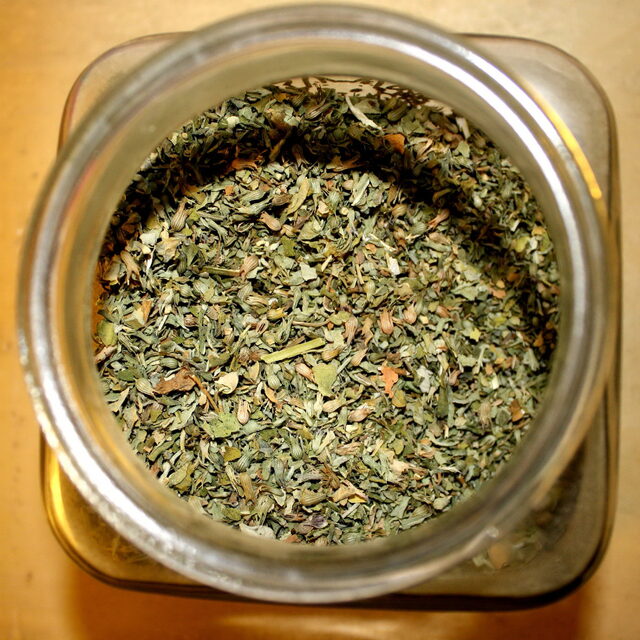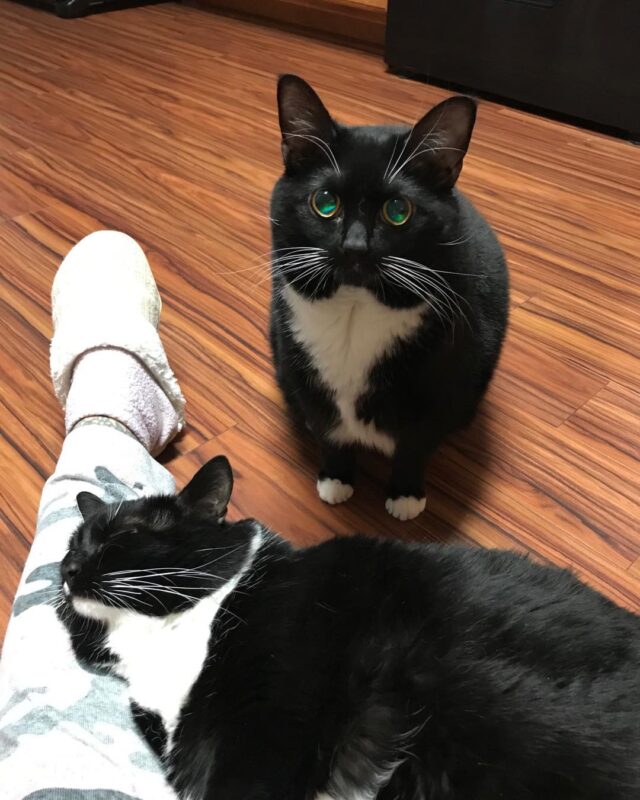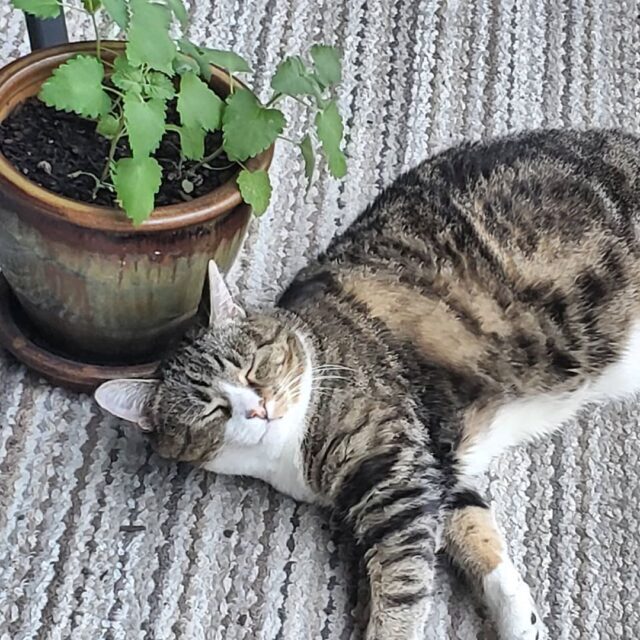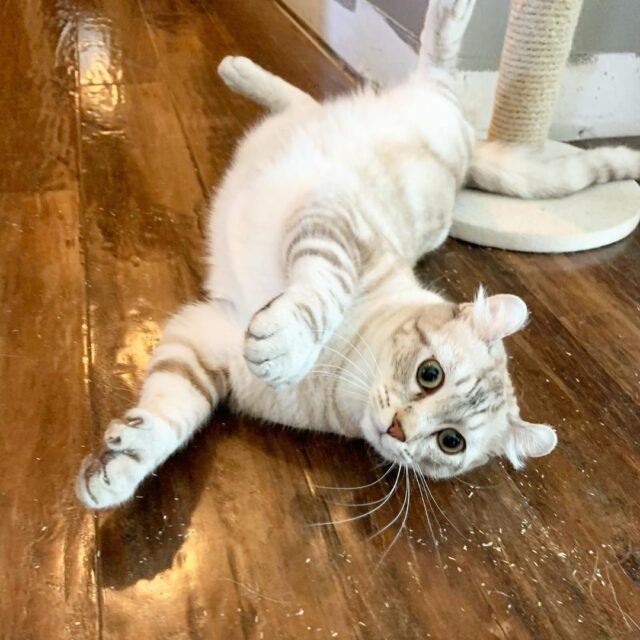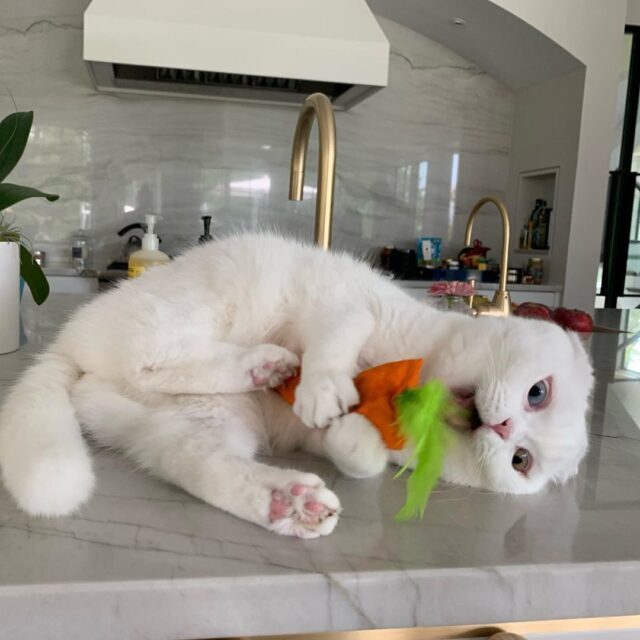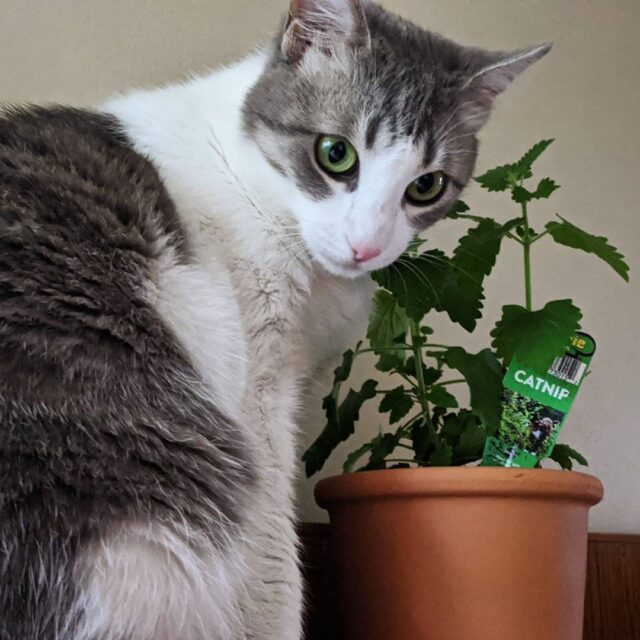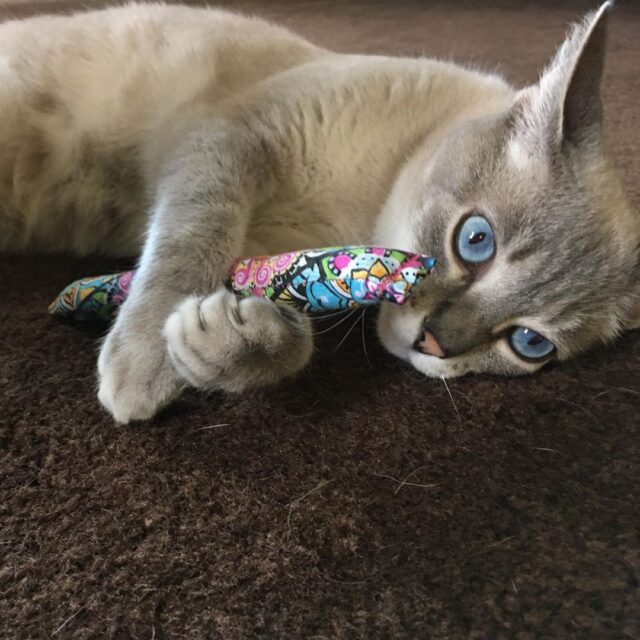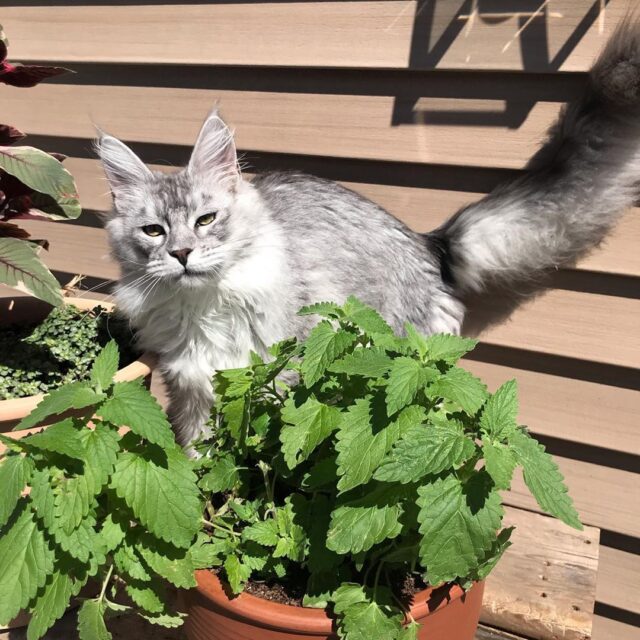Catnip: the magical herb that turns some cats into zooming lunatics and others into blissful puddles of fluff. But what exactly is catnip, and why does it have such a strange effect on our feline friends? From its euphoric highs to the cats who couldn’t care less, let’s explore the fascinating world of catnip—what it is, how it works, and whether it’s right for your kitty!
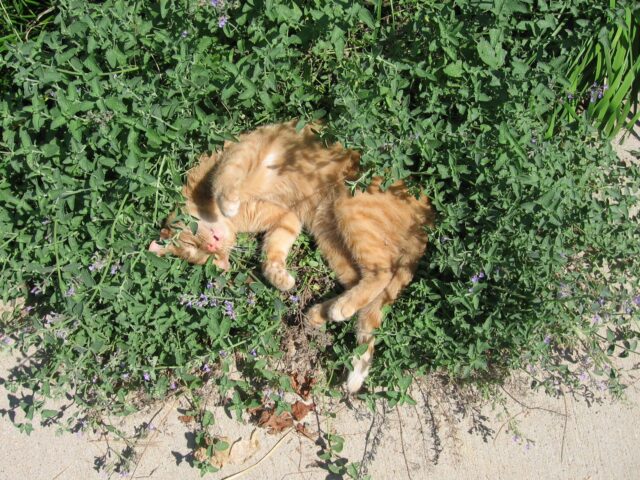
What’s the Deal with Catnip?
Not all cats react the same way to catnip, but for those who do, it can be pure joy! Here’s what you need to know about this feline favorite.
About Your Cat’s Favorite Plant
A fluffy green plant with heart-shaped leaves and scalloped edges native to the Eurasian continents but now grown worldwide, catnip (Nepeta cataria) is in great demand for cat parents who want to please their kitties. As the plant is part of the mint (Lamiaceae) family, it’s related to other savory herbs such as rosemary, sage, oregano, and basil.

Catnip leaves and stems contain a fragrant oil responsible for getting cats ‘high’.
And beyond attracting cats, the University of Wisconsin Master Gardener Division reports pollinators love the delicate white or lavender flowers too. “Bees of all types, wasps and flies, as well as many different types of butterflies, visit the nectar-laden flowers.”
While the fragrant leaves are a favorite smell to cats, “many people are not enamored of their pungent odor, variously described as a combination of thyme and oregano to ‘mildly skunky’”.
We know the kitties can smell the skunky aroma from quite a distance, but how strongly can they smell it? Herbalist Debs Cook explains, “Cats are very sensitive to the scent given off by catnip, in fact, they can smell nepetalactone even if it’s 1 part per 1,000,000,000,000 (trillion) parts in the air.”
Wow! The smallest whiff of catnip will bring a cat running for the good stuff!
What Does Catnip Do to Cats?
We know the plant can hype cats up, but exactly how does catnip work on cats to make them so crazy?
Found in the stems and leaves of catnip, nepetalactone is the chemical compound that draws cats to the catnip plant. Once the nepetalactone oil is inhaled, it triggers the wild response in cats by entering the nasal passages and activating sensory neurons, which tell the brain something good is coming. Once that silliness begins, cat parents then see “the cat exhibits behaviour similar to that seen in response to cat pheromones.”
But catnip doesn’t work on all cats.
Its been long thought only an estimated 50 to 70 percent of adult cats react to the herb. But now, Dr. Bruce Konreich, an associate director with the Feline Health Center at the Cornell University College of Veterinary Medicine, reported more cats than initially thought might be affected by catnip. Those previously thought to be unaffected by the plant actually might be feeling it to a lesser degree.
Cats once thought immune “assume what’s called a kind of sphinx position, and they vocalize less.”
If you see your cat sitting in this way after an encounter with catnip, then perhaps she is feeling the effects, but she handles her high like a mellow kitty.
Catnip love is also an inherited sensitivity. Brother and sister Tigger and Roo, seen below, could care less when their mom puts out some catnip. Their genetics tell them both to say no thanks. But their adoptive siblings all behave in their own ways.
Talking about catnip with iHeartCats, Tigger and Roo’s mom shared, “I have 7 cats and catnip affects each of them differently. Tigger and Roo aren’t affected by it. Frederick and KitTon get aggressive. Zoey likes to roll around and meow. Casey likes to eat it and go lay down and DJ takes a couple of sniffs then walks away.”
This feline family of seven provides a great example of the varied responses cats exhibit when it comes to Nepeta cataria.
And how long does catnip affect a cat?
After interacting with the live plant, dried bits, or infused toy, cat parents can expect catnip affects to last around 10 minutes, according to The Humane Society. And kitties will need a break from the herb. “It may take as long as two hours for him to “reset” and become susceptible to catnip again.”
When Cats Eat Catnip Versus Smelling It
In addition to smelling catnip, you’ll often find cats eat it too. But what happens when a cat chows down on the herb? Don’t be surprised if your fierce kitty gets sleepy after lapping up those dried bits with their tongues.
The effects when consumed are certainly different than when inhaled. In fact, you can expect just the opposite. While putting their noses in a pile of catnip makes kitties go wild, eating it often results in a sedative effect for cats, making for a chill kitty.
Benefits of Catnip
The effects of catnip on a cat go well beyond that momentary feelgood. Dr. Joseph Mercola explains catnip has health benefits for cats too:
- Boredom – An under-stimulated cat can pick up bad behaviors and catnip is one easy way to bust a cat’s boredom as well as help their physical prowess. By offering cats catnip toys, those bored senses get fired up, leading to stimulation of mind and body.
- Stress – When eaten, “Catnip may help keep your cats relaxed during events that may trigger extreme anxiety.” Since cats relax when eating catnip, feeding it to kitties on a treat when they’re worked up can help them calm down and handle stressful situations with their usual feline grace.
- Cat poots – Yes, its true, a simple plant can reduce your cat’s farting habit as “catnip is a carminative which means that it promotes the removal of gas from the intestines.” And anything that helps with stinky cat toots is quite welcome at home!
- Itchies and scratchies – Catnip can bring relief to cats suffering from skin conditions. Whether allergies or bug bites, “giving your pet a catnip tea bath will not only help soothe their irritated skin but may also help ward off fleas and ticks. Catnip has been proven to be more effective in repelling insects than DEET.”
- Settling nerves – The addition of a new cat to the family can cause confusion for all cats involved. Catnip can settle everyone’s nerves and aid in introductions by soothing ruffled feathers.
Your Burning Questions About Catnip
Is catnip safe for cats?
Before giving their cats something new, cat parents tend to worry. But they needn’t fret over catnip. Catnip is not harmful to cats, nor does it cause addiction.
How much catnip should I give my cat?
As a plant potent to cat noses, remember a little goes a long way. Only put down a pinch of dried herb at a time. Cats will scatter it about themselves by rolling in the little pile.
Can cats overdose on catnip?
Cats cannot overdose on catnip. Felines can sometimes overindulge and eat too much, which may cause vomiting and diarrhea. But this is rare as cats are good judges of when they’ve had enough. Do keep an eye on your cat if he overdoes the munching. If tummy distress arises, make sure he drinks plenty of water to stay hydrated.
How do I give it to my cat?
There are several ways to administer catnip to cats.
In the dried and ground form, catnip can be sprinkled liberally anywhere you need. On scratching posts to encourage use, on the floor for roll around and playtime, and even in bedding and blankets to help a cat know something is for them. Bags of catnip are easy to purchase, sold pretty much everywhere. To keep it fresh and protect the integrity of the nepetalactone oil, store bags in the freezer.
Catnip-infused toys are a perfect pairing. Cats get their fix while holding onto a toy so the playtime fun can start right away. By adding catnip to toys, lazy cats can be encouraged to more activity. For extra silly cat fun, try out catnip bubbles.
Sprays containing catnip aren’t as potent as direct administration of dried herb or toys, but these sprays provide a training tool for helping direct cats toward good behavior.
Cats can simply eat the live plant too. As they swat or bite at the growing plant, the fragrant nepetalactone oil contained within is released from the crushed and torn leaves, initializing the silly cat response.
Can kittens have catnip?
Kittens don’t typically respond to catnip until reaching the age of 3 – 6 months. Before that, kittens will generally ignore it and maybe even go out of their way to get away from the strong odor. As your kitten ages, offer her a tiny pinch from time to time. Eventually, she will either show signs of interest or grow into a cat who doesn’t care much for it.
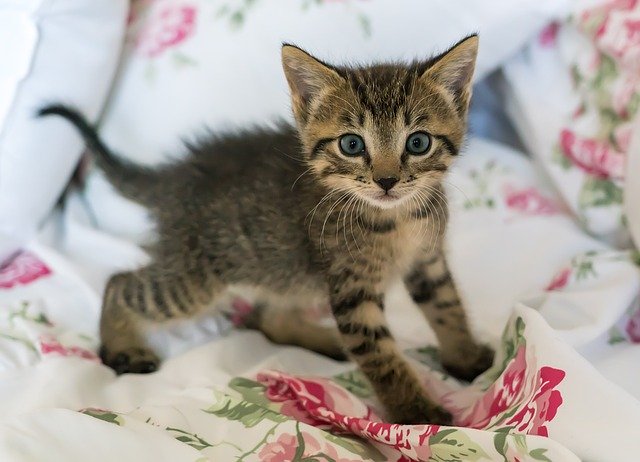
Kittens and senior cats don’t typically react to catnip.
Like kittens, senior cats don’t care about catnip so much, growing immune to the euphoric effects of nepetalactone as they age. So don’t worry if your old man tabby doesn’t like to get silly with the herb anymore.
Can pregnant cats have catnip?
No. Don’t give catnip to pregnant cats. As catnip stimulates the uterus, it is not safe to give pregnant females as it can stimulate premature labor, bringing harm to fetal kittens.
Does catnip make cats hungry?
Catnip can enhance a cat’s hunger. As an appetite stimulant that also encourages cats to get frisky and exercise, catnip will probably send your cat in search of snacks after the high wears off. After curing his case of the munchies, your kitty man will most likely crash for a nap too.
Does catnip hurt dogs?
Catnip is not harmful to dogs but does not elicit the hyperreaction it does in cats. In fact, dogs that eat the plant, whether dried or fresh, might get drowsy.
What is silvervine?
If your cat isn’t crazy for catnip, perhaps silvervine is the answer. A group of cat experts studying feline responses to catnip, silver vine, Tatarian honeysuckle, and valerian found, “Of the cats that did not respond to catnip, almost 75% did respond to Silvervine and about one out of three to Tatarian honeysuckle.”
A long-used plant on the Asian continent, Silvervine also contains nepetalactone and creates a euphoric response in cats. Its effects can last up to 30 minutes, compared to catnip’s 10-minute average.
How to Grow Catnip for Your Cat
Growing a meowdow of catnip for your kitty is pretty simple!
When choosing what to plant for your cat, be sure you select seeds or plants of the right nepeta. Garden & Happy explains, “Catnip (Nepeta cataria) usually refers to the herb, whereas catmint (Nepeta mussinii) is more ornamental and less attractive to cats.”
In the springtime, plant seeds or starts in a sunny location after all danger of frost has passed. And be warned, catnip plants can spread easily. Standing up to 3 or 4 feet tall, the plant takes up some room, so be sure you place seeds and starts around two feet apart when planting.
If you choose to grow it outside, you may want to cover the base of the plant with something to keep your cat from rolling on the plant and killing it. Bonnie Plants suggests, “To keep plants from being loved to death, cover each with an arch of chicken wire. The stems can grow up through the holes, yet the plant’s base and roots are protected.”
As a perennial, the plant can continue to grow outside in warm temps. Freezing weather will kill the plant. If planting indoors, plants can be grown year-round in tip-proof containers, removing the worry of a wintry death for your plant.
Once the stems have grown to 6 – 8 inches tall and filled in with fuzzy green leaves, you can begin harvesting for drying purposes.
Follow these tips from Hobby Farms on how to dry catnip:
- Bundle stalks together and place them upside down in clean paper bags.
- Hang the bags in a dark, dry place until the plants inside have dried out completely.
- Depending on the temperature of the drying area, the process can take a couple of weeks to a month.
- Once dry, break the leaves and flowers into small bits, discarding stems as you go.
- Store in air-tight containers in the freezer for maximum freshness.
Your cat will thank you for the home-grown treat!
Whether growing or purchasing it, your cat will love you for giving them the fragrant herb. Truly a plant that enriches cat lives, pick up some catnip today to please your kitty overlord. Plus, while His Majesty has a ball, you’ll enjoy the silly show!
A Little Catnip Goes a Long Way
Catnip can be a fun and enriching treat for many cats, but moderation is key. Whether it sends your kitty into playtime overdrive or leaves them in a blissful daze, it’s a safe and natural way to add excitement to their routine. Just be sure to let your cat decide if they’re a fan—because, as always, they’re in charge!


